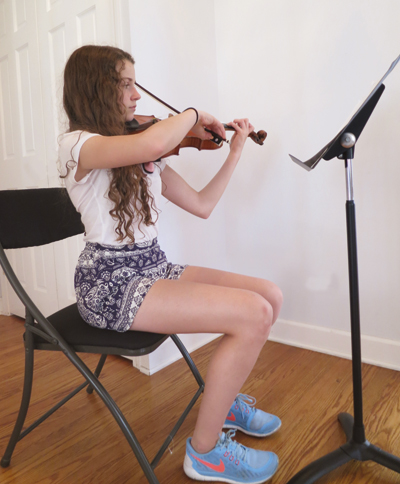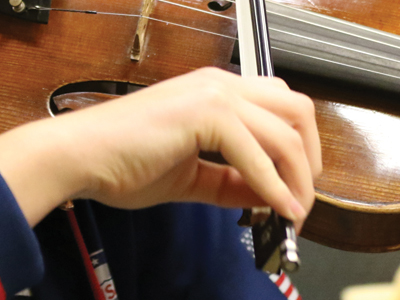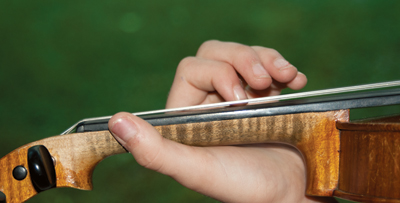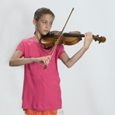Students are always eager to get right to playing new music, but taking some time to review the basics of holding the instrument and bow and developing proper playing posture will pay great dividends down the road. Without a proper setup, students will never be able to play freely and well.
Keep it Fun
One intense string teacher required her very young students to make 2,000 perfect bow holds on a practice bow before graduating to 2,000 more on a real bow – all before playing a note. Their bow holds were beautiful, but it was very frustrating and not practical in most school group situations. Instead, spend 5 minutes at the start of each rehearsal to get everyone set up properly and then pause for quick reminders periodically.
Make it a game
• Race to see who can make the fastest correct bow hold.
• Pair everyone up and have them check their partner’s bow hold or posture.
• Call out “freeze” unexpectedly for a quick check of posture, bow hold, etc.
• Ask a student (or do it yourself) to demonstrate a bow hold or posture and deliberately do something wrong. Ask the other students what should be corrected.
Posture
A droopy violin that is not secure on the shoulder is a major problem for many young players.
1. Make sure students have enough room to hold up their instruments. Check positioning of stands and chairs. (A student who often moves the chair too close to the stand may need glasses.)
2. Because students grow so quickly, be sure to check shoulder rests and chin rests periodically to make sure that students can comfortably hold the instrument up in the correct position.
.jpg)
The player’s head slightly tilts to the left to create a straight line from the nose to the bridge to the scroll over the left foot. Both of the player’s arms are up and away from the body. Avoid a hunched inward position. Students should be able to drop their hands and still hold up the instrument.
Posture, Part 2
As with all instrumentalists, how violinists sit is very important. Students in orchestras often lean back and stick their feet underneath the chair or in various other odd contortions.
Insist that students sit up properly on the edge of their seats with feet flat on the ground before playing. The left foot may be placed slightly further forward, as it is when standing, and the back should be straight.

When students start to slump or lean back, the violin droops, the left arm moves closer to the body, and the bow arm rests against the right side. It is impossible to play properly in this position!
.jpg)
Bow Hold Tips
A good bow hold is essential to producing a good sound and developing bow techniques.
A good bow hold is relaxed but firm.
• The index finger curves gently around the stick of the bow between first and second knuckles with the knuckles angled slightly toward the tip of the bow. It should not hook around the stick.
• Middle fingers hang loosely over the stick a slight space away from the pointer finger. Usually they lie over the black part of the frog.
• The pinky finger should be bent and rest on top of the stick but not as far back as the screw.
• The thumb goes between the grip and the frog and should be bent, not straight. It lies under the middle finger or between the index and middle finger. Beginners may start with the thumb under the frog (still bent) but should switch after a year or so.
• The wrist bends up and in towards the instrument at the frog and pulls backwards as the down bow moves toward the bow tip. Some teachers tell students to think of “smelling” their wrist as they move in an up bow so students remember which direction the wrist moves.
• Stay on the bow highway! Remind students to keep the bow moving in a straight line in between the fingerboard and bridge. (More advanced students will learn how to adjust this positioning for different dynamics and effects.) With young students, place a piece of tape on the wood to show the correct path. Another useful idea is to have students wipe off the rosin on the fingerboard with a clean cloth at the start of rehearsal and then rosin their bows. At the end of rehearsal, have them check where the rosin is located.
The pinky balances on top of the stick, and the index finger curves gently. As the bow moves from frog to tip, the hand and pinky position is not rigid. The bow should feel secure and relaxed in the hand.
.jpg)
Students should not play with the fingers (pinky especially) extended and locked. This pushes the bow away from the hand. Watch that the fingers remain relaxed and not overly straight.

Left Hand
The left hand and wrist position affect how easily students can shift and play fast passages. Problems often arise from poor posture, but in other cases, they are simply bad habits.
The thumb may point up or angle slightly towards the pegs.

When shifting, the hand moves as a unit. Students should not grip the neck with their hands, or it is hard to move.

Fingers should hover over the strings when not in use. Students should watch for fly-away fingers – especially the pinky.
.jpg)
Watch that the thumb is not left behind when shifting or moving between strings.

When students feel as though the violin may slip and fall, they often allow their wrist to hold up the instrument by pressing it against the neck of the instrument. If this happens, double check the shoulder rest support and then have students practice dropping the left hand away from the instrument without letting the violin bobble.
.jpg)





